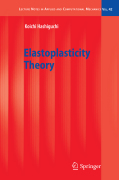
This book was written to serve as the standard textbook for instruction of elastoplasticity theory. It opens with an explanation of the mathematics and continuum mechanics which are necessary as a foundation of elastoplasticity theory. Subsequently, conventional and unconventional elastoplasticity theories areexplained comprehensively for description of general loading behavior covering monotonic, nonproportional, and cyclic loading processes. Fundamental notions such as continuity and smoothness conditions, decomposition of deformation into elastic and plastic parts, the associated flow rule, the loading criterionand the anisotropy are defined, and then presented with their mechanical interpretations. Explicit constitutive equations of metals and soils, which are useful in engineering practice for the mechanical design of machinery and structures, are also introduced. Presents a comprehensive explanation of elastoplasticity basic concept and the recent state of elastoplastic constitutive relations INDICE: Tensor Analysis.- Motion and Strain (rate).- Conservation Laws andStress Tensors.- Objectivity and Corotational Rate Tensor.- Elastic Constitutive Equations.- Basic Formulations for Elastoplastic Constitutive Equations.- Unconventional Elastoplasticity Model: Subloading Surface Model.- Cyclic Plasticity Model: Extended Subloading Surface Model.- Viscoplastic Constitutive Equations.- Constitutive Equations of Metals.- Constitutive equations of soils.- Corotational Rate Tensor.- Localization of Deformation.- Return Mapping Method.- Constitutive Equation for Friction.
- ISBN: 978-3-642-00272-4
- Editorial: Springer
- Encuadernacion: Cartoné
- Páginas: 350
- Fecha Publicación: 01/04/2009
- Nº Volúmenes: 1
- Idioma: Inglés
